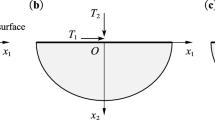Abstract
This contribution derives thermodynamically consistent balance equations for material interfaces in thermomechanical solids. Thereby, both displacement and temperature jumps are admissible. To this end, the interface is equipped with its own thermodynamic life, i.e. we assume separate interface free energy, entropy and the like. The thermodynamical admissibility then follows from proper definitions of the interface displacement and the interface temperature, whereby in particular, the latter follows in an unexpected format. The formulation is exemplified for the example of thermoelasticity.
Similar content being viewed by others
References
Abeyaratne, R., Knowles, J.K.: Dynamics of propagating phase boundaries: thermoelastics solids with heat conduction. Arch Rat Mech Anal 126, 203–230 (1994)
Danescu, A.: Generalized Stefan models acounting for discontinuous temperature field. Continuum Mech Thermodyn 16, 427–439 (2004)
Dems, K., Mroz, Z.: Shape sensitivity analysis and optimal design of disks and plates with strong discontinuities of kinematic fields. Int J Solids Struct 29, 437–463 (1992)
Dems, K., Mroz, Z.: Sensitivity analysis and optimal design of external boundaries and interfaces for heat conducting systems. J Therm Stresses 21, 461–488 (1998)
Ericksen, J.L.: Tensor fields. handbuch der Physik, Vol III/1. Springer, Berlin Heidelberg New York (1960)
Fried, E., Shen, A.Q.: Generalization of the Stefan model to allow for both Velocity and temperature jumps. Continuum Mech Thermodyn 11, 277–296 (1999)
Gurtin, M.E.: The nature of configurational forces. Arch Rat Mech Anal 131, 67–100 (1995)
Gurtin, M.E.: Configurational forces as basic concepts of continuum physics. Springer, Berlin Heidelberg New York (2000)
Landau, L.D., Lifshitz, E.M.: Fluid mechanics. Pergamon, New York (1987)
Mariano, P.M.: Multifield theories in mechanics of solids. Adv Appl Mech 38, 1–93 (2001)
Mariano, P.M.: Configurational forces in continua with microstructure. ZAMP 51, 752–791 (2000)
Peric, D., Saksono, P.H.: On finite element modelling of surface tension: variational formulation and application. Trends Comput Struct Mech, CIMNE, Barcelona, 2001 pp. 731–740
Petryk, H., Mroz, Z.: Time derivatives of integrals and functionals defined on varying volume and surface domains. Arch Mech 38, 697–724 (1986)
Pozrikidis, C.: Introduction to theoretical and computational fluid mechanics. Oxford University Press (1997)
Truesdell, C.A., Toupin, R.A.: Classical field theories. Handbuch der Physik, Vol. III/1. Springer, Berlin Heidelberg New York (1960)
Author information
Authors and Affiliations
Rights and permissions
About this article
Cite this article
Steinmann, P., Häsner, O. On material interfaces in thermomechanical solids. Arch Appl Mech 75, 31–41 (2005). https://doi.org/10.1007/s00419-005-0383-8
Received:
Accepted:
Published:
Issue Date:
DOI: https://doi.org/10.1007/s00419-005-0383-8




